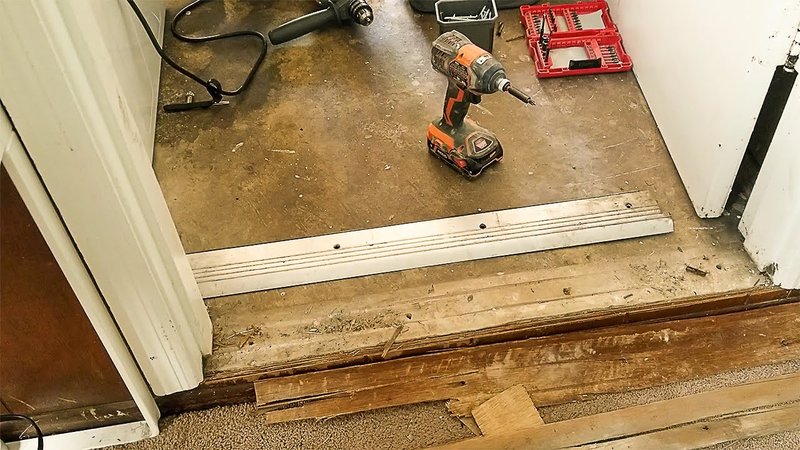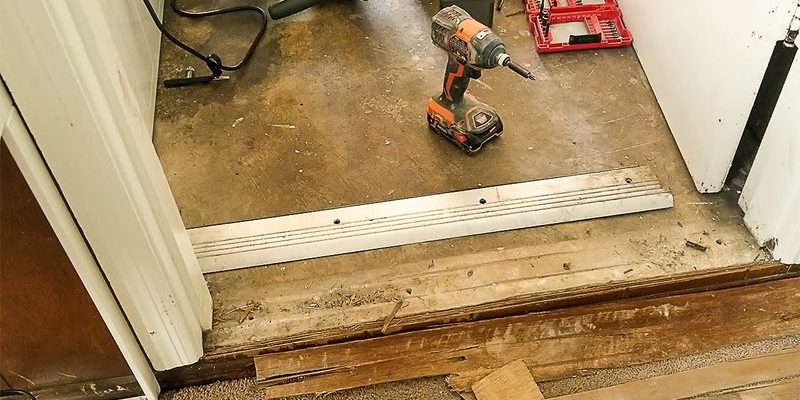
Honestly, it’s easy to get confused about what’s happening. Is the door warped? Is the floor rising up? Or did the threshold itself just get knocked out of place when you weren’t looking? If you’ve got a wooden front door from brands like Masonite or Jeld-Wen, or a steel exterior door, the cause and solution might look a bit different—but the troubleshooting steps are pretty similar. Let me explain how to figure out what’s going on and, more importantly, how to fix it.
What Does It Mean When a Door “Catches” on the Threshold?
When people say their door is “catching” on the threshold, they usually mean the bottom edge of the door is scraping or snagging as it moves over the raised strip of material at the bottom of the door frame. The threshold’s job is to seal the gap under the door, keeping out drafts and water. But if things aren’t lined up just right, friction builds up where there shouldn’t be any.
You might be wondering: “Is this normal wear and tear, or is something actually broken?” For a brand-new door, it might just be a bit of swelling from humidity or a minor installation tweak. For older doors, repeated catching can make things worse by damaging the bottom edge or even throwing the whole door out of alignment.
Here’s the thing—this isn’t just about convenience. If your door isn’t closing smoothly, you could also be dealing with energy loss, pest entry, or even moisture sneaking in. So, understanding what’s happening at that threshold is step one in taking back control (and saving yourself a lot of future frustration).
Diagnosing Why Your Door Is Catching
Before you grab a toolkit, it’s smart to figure out exactly why your door is catching on the threshold. Even among pros, the root cause isn’t always obvious at first glance. Let’s break down the most common suspects, so you don’t waste time fixing the wrong thing.
- Door sag or misalignment: Over time, hinges can loosen or the structure can shift, so your door doesn’t clear the threshold like it used to.
- Threshold height issues: Sometimes the threshold itself rises (thanks to swelling wood, loose screws, or improper installation) and starts making contact.
- Swollen materials: Wood doors and thresholds especially can swell with humidity, raising parts of the door or the sill just enough to cause problems.
- Incorrect weatherstripping: Too-thick or poorly installed weatherstripping under the door can cause dragging or sticking as well.
A quick way to figure out what’s what: Open the door and look at the gap along the bottom. If you see uneven spacing, or if the door gets easier or harder to move at different points, you’ve got a classic sign of alignment or threshold problems. For metal doors, check for bent lower edges. For wood doors, look for swelling, dents, or paint scraping off at the bottom.
Checking the Threshold for Height and Damage
Let’s get hands-on. The threshold is typically a strip of wood, metal, or composite running across the floor at the doorway. Its main job: create a tight seal while letting the door open smoothly. But too much height, damage, or warping can ruin everything.
Start by inspecting the threshold for *visible* problems—look for bumps, cracks, or spots where the material is noticeably higher. Run your hand along the top; if you feel an obvious high spot, that’s likely where the door is catching. Some thresholds have adjustable screws; try pressing down gently to see if anything moves. If the threshold is loose, it can lift under the weight of the door and cause catching.
For wooden thresholds, look for water damage or swelling. If it’s squishy or discolored, moisture may have gotten in, causing it to expand and push up against the door. For metal thresholds, dents or warping from shoes, carts, or heavy objects can create problem areas.
If you have an adjustable threshold, this is your moment. Check if the screws can be turned to lower the profile. On older doors, you may need to tighten or replace the threshold altogether.
How to Adjust a Threshold That’s Too High
Some thresholds are designed with adjustment in mind. If yours has visible screws along the top (typically Phillips-head), they control the height. Turn them clockwise to lower the threshold; counterclockwise to raise it. Don’t overdo it—a quarter turn at a time is plenty. Open and close the door after each tweak to check your progress.
If your threshold isn’t adjustable, you’ve still got a few options:
- Remove built-up debris: Sometimes, dirt or old weatherstripping is sitting on top of the threshold, adding extra height.
- Careful sanding: For wooden thresholds, light sanding can take down any raised spots.
- Replace worn parts: If the rubber insert or metallic strip is sticking up, see if you can replace just that part rather than the whole threshold.
In extreme cases—say, the threshold is so high that nothing else works—you may need to remove and reinstall it at the correct height. That’s more of a weekend project, but it’s often worth it if you want smooth operation (and to stop listening to that scraping sound every single day).
What to Do If the Door Itself Is the Culprit
Sometimes, it’s not the threshold that’s the problem at all—it’s the door. This usually happens if the door sags, warps, or has swollen from moisture. Here’s how you can spot this: With the door open, look along the bottom edge. If it’s uneven, rough, or showing scrape marks, there’s your answer.
Let me walk you through some fixes:
- Tighten or adjust hinges: Sagging often starts at the top hinge; tightening the screws can lift the door just enough.
- Sand or plane the bottom edge: If there’s swelling or damage, a little sanding can restore clearance. Always seal and paint the sanded area to prevent further moisture problems.
- Replace weatherstripping: If it’s too thick or bunched up, swap it out for a slimmer profile.
You might be nervous about taking a hand plane or sander to your door. That’s normal! Start small and test the fit after every few passes. For steel or fiberglass doors, you’ll need to be more careful—just a light sanding, or talk with a pro if you hit stubborn spots.
How Weather and Seasons Affect Threshold Problems
Doors and thresholds don’t live in a vacuum—they’re at the mercy of your home’s environment. When the weather shifts, so can the materials in your door and threshold. Humid summer? Expect some swelling. Dry winter air? Things might shrink back, creating bigger gaps.
For example, wooden doors and thresholds are like sponges—they soak up moisture and can swell, pushing the door down onto the threshold. Metal thresholds don’t swell, but the wood underneath them can shift. Even composite or vinyl pieces can expand and contract with temperature swings.
If you notice that your door only catches during certain seasons, that’s a big clue that moisture is to blame. Try running a dehumidifier in the area as a quick test. Sometimes, trimming the door or threshold is a good fix, but always leave a little “wiggle room” for future expansion so you’re not repeating the process next year.
When to Consider Replacing the Threshold
You might reach a point where fixing just isn’t worth it. If your threshold is cracked, rotten, or so deformed that you can’t adjust it—replacing is often simpler and more reliable in the long run. Thankfully, thresholds are easy to find at most hardware stores, and many come in adjustable designs for future-proofing.
Here’s what to expect with a replacement:
- Remove the old threshold carefully, watching for nails, screws, or adhesives.
- Clean the area underneath and check for water damage—repair as needed before installing the new piece.
- Measure and cut the new threshold to fit, making sure it sits flush and level with both the sill and the bottom of the door.
- Secure it in place, using screws or adhesive as recommended by the manufacturer. Most thresholds today have some adjustment built-in for fine-tuning after installation.
If you’re installing a brand-specific piece (like one from Masonite or Jeld-Wen), follow those instructions closely. Universal thresholds can be a lifesaver, but double-check the width and depth before you start cutting anything.
Preventing Future Threshold Problems
After all this troubleshooting, you’ll want to keep the good vibes going. Regular upkeep is honestly your best friend here. Every few months, give your door and threshold a once-over. Tighten screws, clear away dirt and debris, and check for any signs of swelling or damage.
If you’ve got a wooden threshold or door, make sure it’s sealed and painted to keep out moisture. For metal and composite designs, keep the channels clean so water doesn’t build up and cause rust or warping underneath.
If your threshold is adjustable, get into the habit of checking the screws during major weather changes. One quick tweak in spring or fall can save you a whole season of hassle.
Doors and thresholds are like any good partnership—they work best when they’re both in sync. Regular troubleshooting and maintenance keep things running smoothly… and stop those daily annoyances from piling up.
Wrapping It Up: Enjoy a Smooth-Operating Door Again
At the end of the day, fixing a door that’s catching on the threshold is about patience and a bit of detective work. Most of the time, the problem isn’t as complicated as it seems—just a matter of loose screws, swelling wood, or a threshold that’s sitting a bit too high. By checking both the door and the threshold, making a few careful adjustments, and staying on top of regular maintenance, you’ll keep your entryways working the way they should.
No more wrestling matches at your front door. Just smooth, easy, satisfying clicks—every time you come and go.
